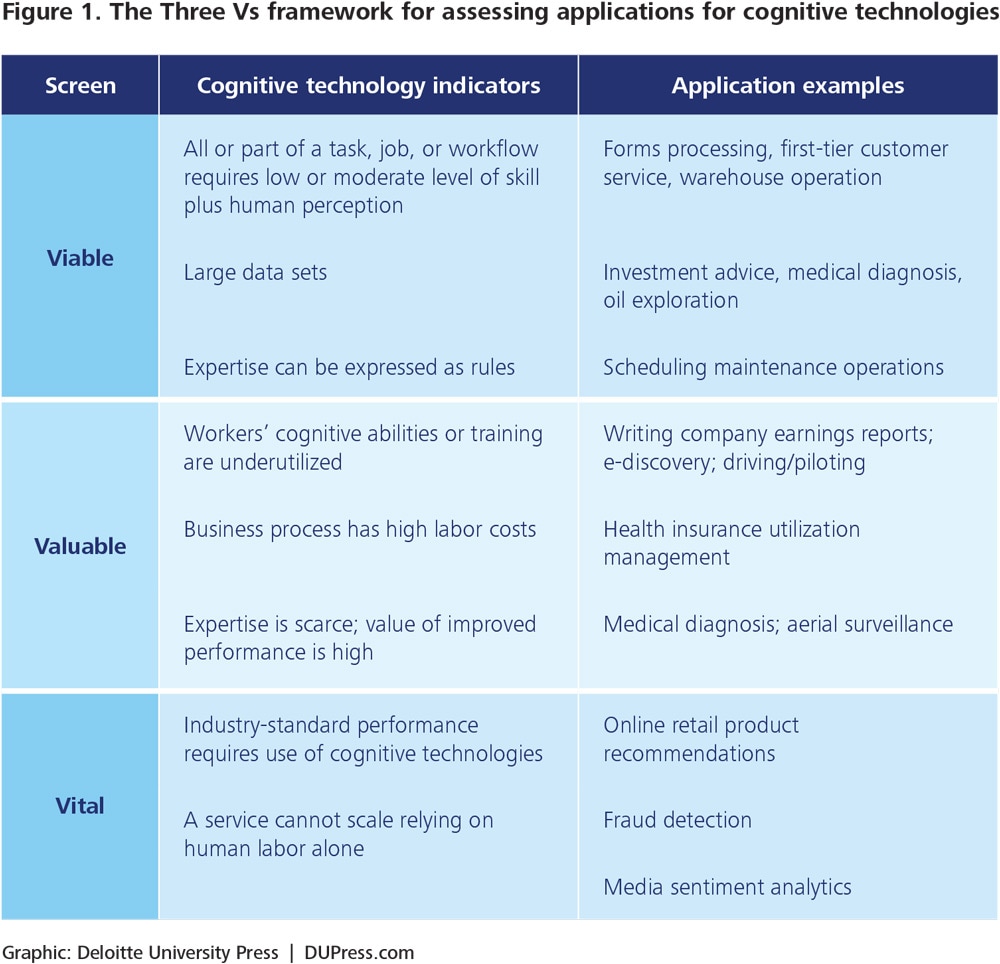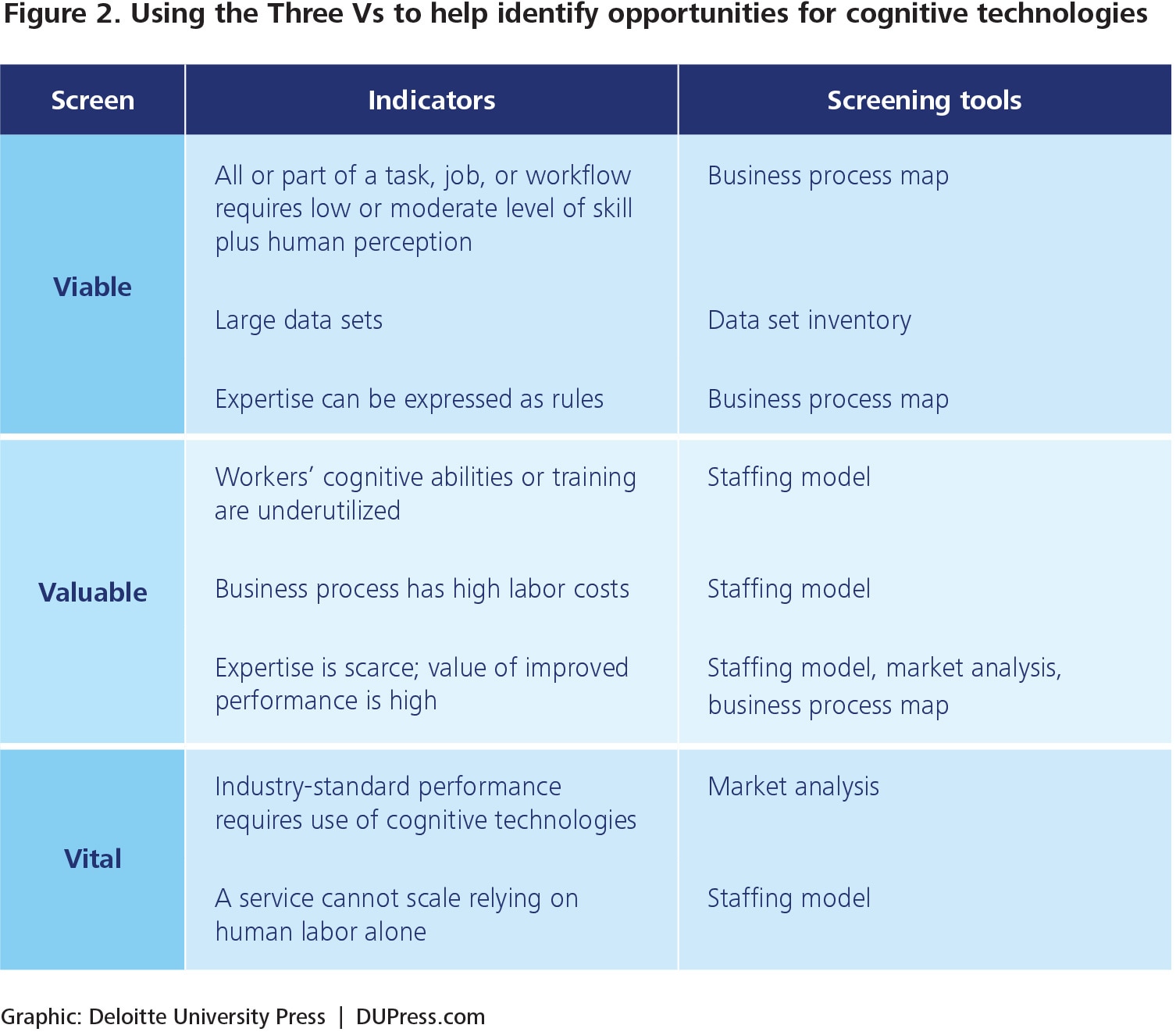Cognitive technologies: The real opportunities for business has been saved

Cognitive technologies: The real opportunities for business Deloitte Review Issue 16
27 January 2015
Because cognitive technologies extend the power of information technology to tasks traditionally performed by humans, they can enable organizations to break prevailing trade-offs between speed, cost, and quality. We present a framework by which to explore where cognitive technologies can benefit your company.

Computers cannot think. But increasingly, they can do things only humans were able to do. It is now possible to automate tasks that require human perceptual skills, such as recognizing handwriting or identifying faces, and those that require cognitive skills, such as planning, reasoning from partial or uncertain information, and learning. Technologies able to perform tasks such as these, traditionally assumed to require human intelligence, are known as cognitive technologies.1
A product of the field of research known as artificial intelligence, cognitive technologies have been evolving over decades. Businesses are taking a new look at them because some have improved dramatically in recent years, with impressive gains in computer vision, natural language processing, speech recognition, and robotics, among other areas.
Because cognitive technologies extend the power of information technology to tasks traditionally performed by humans, they have the potential to enable organizations to break prevailing tradeoffs between speed, cost, and quality. We know this first hand: The authors of this article have been aggressively experimenting with cognitive technologies in our own business and deploying multiple solutions based on them with great effect. And our colleagues are working with numerous clients to apply these technologies to diverse business challenges.
Over the next five years we expect the impact of cognitive technologies on organizations to grow substantially. Leaders of organizations in all sectors need to understand whether, how, and where to invest in applying cognitive technologies. Hype-driven, ill-informed investments will lead to loss and sorrow, while appropriate investment can dramatically improve performance and create competitive advantage. Below we outline principles that should help leaders make better decisions about cognitive technologies.
Defining artificial intelligence
A useful definition of artificial intelligence is the theory and development of computer systems able to perform tasks that normally require human intelligence.
How cognitive technologies are used in organizations
How are cognitive technologies being used in organizations today? To answer this question we reviewed over 100 examples of organizations that have recently implemented or piloted an application of cognitive technologies. These examples spanned 17 industry sectors, including aerospace and defense, agriculture, automotive, banking, consumer products, health care, life sciences, media and entertainment, oil and gas, power and utilities, the public sector, real estate, retail, technology, and travel, hospitality, and leisure. Application areas were broad and included research and development, manufacturing, logistics, sales, marketing, and customer service.
We found that applications of cognitive technologies fall into three main categories: product, process, or insight. Product applications embed the technology in a product or service to provide end-customer benefits. Process applications embed the technology in an organization’s workflow to automate or improve operations. And insight applications use cognitive technologies—specifically advanced analytical capabilities such as machine learning—to uncover insights that can inform operational and strategic decisions across an organization. We explore each application type below.
Product: Products and services embedding cognitive technologies
Organizations can embed cognitive technologies to increase the value of their products or services by making them more effective, convenient, safer, faster, distinctive, or otherwise more valuable.
A famous early example of the use of cognitive technology to improve a product offering is the recommendation feature of the Netflix online movie rental service, which uses machine learning to predict which movies a customer will like. This feature has had a significant impact on customers’ use of the service; it accounts for as much as 75 percent of Netflix usage.2 A more recent example in the Internet business is eBay, which now uses machine translation to enable users who search in Russian to discover English-language listings that match.3 One thing these examples have in common is that they both encourage greater use of the services, which can increase loyalty and revenues.
Even before self-driving cars become a commercial reality, automakers are using computer vision and other cognitive technologies to enhance their products. General Motors, for instance, is planning to make some of its vehicles safer by equipping them with computer vision to determine whether the driver is distracted or not spending enough time looking at the road ahead or the rear-view mirror.4 Audi is integrating speech recognition technology into some cars to enable drivers to engage in more convenient, natural communication with infotainment and navigation systems.5
A maker of medical imaging technology aims to make radiologists more effective by using computer vision algorithms to identify areas of mammograms that are consistent with breast cancer. The system automatically analyzes mammogram images and outlines suspicious areas to clearly indicate potential abnormalities. VuCOMP, the company that developed the system, cites a clinical study that found radiologists were significantly more effective in finding cancer and in differentiating cancer from non-cancer when using the system.6
The pizza delivery chain Dominos introduced a function in its mobile app that lets customers place orders by voice; a virtual character named “Dom,” who speaks with a computer-generated voice, guides customers through the process. Automating the process of ordering pizza by voice is not primarily a cost-cutting move. Rather, it is intended to increase revenue by making ordering more convenient. Dominos customers increasingly say they prefer to order online or with mobile devices, and those who order this way tend to spend more and purchase more frequently.7 The automated voice ordering system should help the company scale its digital business without adding more call center staff.
To scale and improve the quality of its business news coverage, Associated Press (AP) has implemented natural language-generation software that automatically writes corporate earnings stories. Rather than taking the opportunity to reduce staffing levels, AP is using the technology to increase by a factor of 10 the number of such stories it publishes, enabling AP to cover companies of local or regional importance it did not have the resources to cover before and freeing journalists from writing formulaic earnings stories so they can focus on more analytical and exclusive stories.8
Defining cognitive technologies
Cognitive technologies are products of the field of artificial intelligence. They are able to perform tasks that only humans used to be able to do. Examples of cognitive technologies include computer vision, machine learning, natural language processing, speech recognition, and robotics.
Creating new product categories
Not only can cognitive technologies be used to enhance products and services, they can also bring about entirely new classes of products and services that can create new markets and generate large gains for inventors. The Roomba robotic vacuum cleaner, for instance, created a new category, achieved sales of 10 million units, and spawned several competitors.9 Google Now, which aims to anticipate one’s need for information and provide it before being asked, is an example of another emerging category enabled by cognitive technologies: the automated virtual personal assistant. Unmanned aerial vehicles, robotic pack animals, and robotic caregivers for the elderly or infirm all exemplify the potential of cognitive technologies to create new product categories.10 We will surely see more examples in coming months and years.
Process: Automating internal processes with cognitive technologies
Another category of cognitive technology application is automation. By automation we mean using computer systems to do work that people used to do. The result is that the work gets done faster, cheaper, better, or some combination of the three.11 Automation tends to be internally focused; the organization that implements it, rather than customers, tends to be the primary beneficiary, generally through cost savings or more efficient use of resources.
Cognitive technologies can automate work in two main ways: by augmenting workers or by replacing them. Augmenting means helping a worker do his or her job better or faster, the way power tools help a laborer work faster. Clinical decision support systems that propose diagnoses, suggest medical treatments, or recommend patients for clinical trials are examples of this. So are applications that automatically read and filter news and data to highlight information that may influence a financial advisor’s view of an asset class or stock.12
Some applications of cognitive technologies eliminate jobs by taking on all of a worker’s responsibilities. Automated voice response systems that replace human customer service agents for first-tier customer support are well established. Driverless mining trucks, developed to reduce risks to human drivers and cut labor costs, are relatively new.13
The Hong Kong subway system provides a good example of the use of cognitive technologies for automation to improve quality and efficiency. The performance of the system overall is impressive. It carries over 5 million passengers daily and boasts a 99.9 percent on-time record.14 In a typical week 10,000 workers carry out some 2,600 engineering activities across the system to keep it running smoothly. The operator of the Hong Kong subway system implemented cognitive technologies to automate and optimize the planning of these engineering works. The planning system encodes rules of thumb learned by experts over years of experience plus constraints such as schedules and regulations about maximum noise levels allowed at night. It employs a “genetic algorithm” that pits many solutions to the same problem against each other to find the best one, producing an optimal engineering schedule automatically and saving two days of planning work per week.15 Though it automates the work of experts, it doesn’t replace them. As Andy Chun, CIO for the City University of Hong Kong and the designer of the system said, the human planners “are rare experts in the field. Their time is never enough.” The system “helps relieve them of the scheduling task so that they can focus on tougher issues that require human interactions and negotiations.”16
An important automation application for cognitive technologies is performing tasks at a scale that is impractical with conventional alternatives. The State of Georgia Government Transparency and Campaign Finance Commission, for instance, has to process 40,000 pages of campaign finance disclosures per month, many of which are handwritten. After evaluating other alternatives, they decided they needed a solution that uses automated handwriting recognition to keep up with the workload, coupled with crowdsourced human review to ensure quality.17
To increase the speed and reduce the cost of operations, we expect that organizations of all types will implement cognitive technologies to automate processes that could not be automated without them. A recent study in health care provides an example. The study, at the Cincinnati Children's Hospital Medical Center, demonstrated that the process of automatically identifying patients eligible for clinical trials, using natural language processing to read free-form clinical notes, and machine learning to refine the list of terms extracted from them, reduced the workload by 92 percent and increased efficiency by 450 percent.18
Our research on how companies are putting cognitive technologies to work has revealed a framework that can help organizations assess their own opportunities for deploying these technologies. We suggest organizations look across their business processes, their products, and their markets to examine where the use of cognitive technologies may be viable, where it could be valuable, and where it may even be vital.
Insight: Cognitive technologies learning from information
The third category of cognitive technology application is creating insight. Natural language processing techniques, for instance, make it possible to analyze large volumes of unstructured textual information that has not yielded to other techniques. Machine learning can draw conclusions from large, complex data sets and help make high-quality predictions from operational data. Many companies are using cognitive technologies to generate insights that can help reduce costs, improve efficiency, increase revenues, improve effectiveness, or enhance customer service.
Stevia First, a bio-tech start-up that has developed intellectual property covering the production of a naturally derived sugar substitute, is exploring a range of cognitive technologies to generate insights. One application is optimizing its industrial processes. Rather than explore various production approaches by trial and error, the company uses what it calls “smart search,” driven by cognitive algorithms that it is not ready to disclose, to determine the optimal parameters for the volume of raw materials and process time, for instance, to boost the cost efficiency of the production process.19 The company is evaluating a range of other insight-oriented applications of cognitive technologies, from using natural language processing to automatically read and summarize findings from thousands of biotechnology research papers, to reanalyzing data sets from old research in search of a new gene or a new drug.20
Intel is using machine learning to improve sales effectiveness and boost revenue. One approach it takes is automatically classifying customers using a predictive algorithm into categories that are likely to have similar needs or buying patterns. The resulting categories can be used to prioritize sales efforts and tailor promotions. The company expects this strategy to result in $20 million in additional revenue when rolled out globally.21
To improve marketing and customer service, BBVA Compass bank uses a social media sentiment monitoring tool to track and understand what consumers are saying about the bank and its competitors. The tool, which incorporates natural language processing technology, automatically identifies salient topics of consumer chatter and the sentiments surrounding those topics. These insights influence the bank’s decisions on setting fees and offering consumer perks, and how customer service representatives should respond to certain customer inquiries about services and fees.22
Aetna and GNS Healthcare teamed up to use machine learning and other analytic techniques to improve the health of patients and reduce the cost of caring for them. Their analysis focused on metabolic syndrome, a condition that significantly increases the risk of developing heart disease, stroke, and diabetes. Using claims and biometric data for a population of 37,000 Aetna members, the companies developed models that predicted the risk of developing metabolic syndrome and the probability of developing any of the five conditions associated with the disorder. The models are also able to determine which medical interventions are most likely to improve an individual’s health outlook.23
Three categories, many opportunities
As the examples above have shown, cognitive technologies can be used in a variety of ways to create business benefits. Next, we discuss how to sort through potential opportunities.
Three Vs: A framework for investment
Cognitive technologies are not the solution to every problem. Organizations need to evaluate the business case for investing in this technology in an individualized way. Our research on how companies are putting cognitive technologies to work has revealed a framework that can help organizations assess their own opportunities for deploying these technologies. We suggest organizations look across their business processes, their products, and their markets to examine where the use of cognitive technologies may be viable, where it could be valuable, and where it may even be vital. This “Three Vs” framework is summarized in figure 1. Organizations can use it to screen opportunities for applying cognitive technologies.
Viable
Cognitive technologies have limits that are not widely acknowledged in the business press. They are not truly intelligent in any general sense of the word; they cannot really see, hear, or understand. No robot can excel at tasks that require empathy, emotion, or relatedness. But there is a broad range of problems for which cognitive technologies can provide at least part of a solution. The first step in assessing opportunities for the technology is to understand which applications are viable.
Some tasks that require human or near-human levels of speech recognition or vision can now be performed automatically or semi-automatically by cognitive technologies. Examples include first-tier telephone customer service, processing handwritten forms, and surveillance. Machine learning techniques are enabling organizations to make predictions based on data sets too big to be understood by human experts and too unstructured to be analyzed by traditional analytics. And automated reasoning systems can find solutions to problems with incomplete or uncertain information while satisfying complex and changing constraints. They can automate the decision-making process of experts, such as the engineering managers at the subway system in Hong Kong mentioned earlier.
Valuable
Just because something can be automated with cognitive technologies does not mean it is worth doing so. In other words, what is viable is not necessarily valuable. Automation features that customers do not care about are obviously not valuable. Tasks performed well by plentiful, low-cost workers are not attractive candidates for automation. Tasks that require scarce expertise may be. Some tasks are performed by experts but don’t always require deep expertise. These may be good automation candidates. Accountants who scan hundreds of contracts looking for patterns and anomalies in contract terms, for instance, are using their reading skills more than their accounting skills. It may be valuable in this scenario to use natural language processing techniques to automate the process of reading and extracting the terms from a body of contracts.
Vital
For certain business problems, cognitive technologies may be more than just viable and valuable. They may be vital. Processes that require human perception at a very high scale may be unworkable without the support of cognitive technologies. The Georgia agency mentioned earlier—which has to process 40,000 campaign finance disclosure forms per month, many of which are handwritten—is an example of this. Another example is Twitter, which uses natural language processing to help advertisers understand when, why, and how its users post comments about television shows and TV advertising; this capability would not be possible without cognitive computing to analyze the language of the tweets.24 Fraud detection is another application in which the use of machine learning should now be considered vital. Especially in large-scale online businesses but increasingly, we expect, in businesses of all types, the performance of certain functions will depend on the use of cognitive technologies.
Using three Vs analysis to guide investment in cognitive technologies
We do not intend to suggest, with our simple three Vs framework, that investing in cognitive technologies is a simple matter. The technologies are still evolving, best practices are scarce, and trial and error may be the way forward, especially for novel applications. The viability of an application may depend on factors such as the specific characteristics of the information an organization is working with. Value varies with the evolving level of effort required to implement these technologies. And a dynamic competitive landscape may dictate which applications are vital. With this in mind, we recommend that organizations be systematic when applying the three Vs framework. This means analyzing business processes, staffing models, data assets, and markets to home in on opportunities for applying cognitive technologies. Here’s how:
Create a process map
Use a process map—an inventory of an organization’s main business processes—to reveal workflows where cognitive technologies may have viable and valuable applications. Process maps can highlight tasks that rely more on human perception than special skills, are costly, where scarce expertise might be able to be encoded as rules for use in an automated reasoning system, or where the value of improved performance is high. Such tasks include reviewing documents, compiling evidence, processing forms, answering basic questions, identifying patterns, planning and scheduling, and diagnosing.
Review your staffing model
Review your staffing model to identify roles where cognitive skills and training may be underutilized or where expertise is in short supply. Sifting through clinical notes in patient records to identify candidates for clinical trials is a task that highly trained nurse practitioners do today. But much of the job involves reading and comparing keywords. This represents an opportunity for automation with cognitive technologies.
Perform a data set inventory
Perform a data set inventory to uncover operational data sets that may be under-analyzed and insufficiently exploited. For instance, a jet engine maker is analyzing detailed usage and sensor data from its engines to gain insights about the causes and future timing of maintenance issues.25 Customer behavior data and procurement data, among many other types, could harbor valuable insights ripe for discovery by machine-learning applications.
Conduct a market analysis
Undertake a market analysis to reveal opportunities where improvements in performance or automation features are valuable to existing or new market segments and can differentiate your company’s offerings. For instance, Nest created a new category—smart thermostats—by recognizing that machine learning could bring new levels of convenience and comfort to home climate control.26
Figure 2 summarizes how each type of analysis can help identify viable, valuable, or vital opportunities for cognitive technologies in your organization.
Give preference to value- and growth-building opportunities
Previous research by Deloitte LLP reveals that exceptional companies—those that exhibit superior performance over the long term—tend to differentiate themselves based on value, not price. And they seek to grow revenues before cutting costs.27 An implication of this research is that when prioritizing investments in cognitive technologies, companies should generally favor opportunities to create new or better products or services rather than simply to cut costs. As noted above, Associated Press is taking this approach by using automation and is opting to increase its output of earnings stories rather than maintain its previous level at a lower cost.
Reality check: Humans in the loop
Despite the impressive capabilities of cognitive technologies, nothing we have seen suggests that a wholesale replacement of human workers by robotic substitutes is imminent. Computer vision has made great strides in recent years—Facebook claims it can recognize faces with 97 percent accuracy—but it still cannot generally recognize multiple objects in a scene or reliably understand what actions it is witnessing.28 Technologies like speech recognition and machine translation can greatly boost productivity, but they require human oversight if their work is to be as good as humans’. Systems that use natural language processing can dramatically accelerate the process of analyzing and understanding documents. But they make simple mistakes that an average human would not. And we need humans to act on the insights that may be gleaned by automatic document analysis.
Not only may cognitive systems produce imperfect results, they may also require a significant investment of human time to train or configure before they can do their work. Machine learning systems are routinely exposed to thousands or millions of data elements before they can start reliably making predictions or classifications. Natural language process systems may require a time-consuming configuration process that defines the concepts and vocabulary that are most important to the systems’ users.
For the foreseeable future, then, the use of cognitive technologies implies that humans will be very much “in the loop”—not only to develop, customize, and train the systems, but also to oversee, guide, and improve them. Indeed, a promising approach for making effective use of cognitive systems is designing them to work hand-in-hand with people, leveraging the strength of each. A good example of this is the winning solution to DARPA’s 2011 Shredder Challenge, in which teams were given digital facsimiles of five different shredded documents and challenged to reconstruct them. The winning team developed computer-vision algorithms that automatically suggested pairs of paper fragments that might be from adjacent sections of the page and presented them to human assemblers who could verify them at a glance.29
We believe systems that automate subtasks, or rely on human review of automated results or recommendations such as automated transcription, diagnosis, or anomalous results flagged as possible frauds or errors, will become more common. Systems of this type are likely to be more cost effective than efforts to entirely remove humans from workflows. Because of this, we think organizations will need the skills to design workflows, tasks, and interfaces to enable this kind of person-machine interaction.
Challenges and risks
Recent and ongoing progress in the development and commercialization of cognitive technologies is creating valuable new opportunities for organizations. But these opportunities come with challenges and risks. Some examples are highlighted below.
Unpredictable costs and timelines
Cognitive technologies are evolving rapidly. Highly customized or innovative applications, such as automating the screening of patients for clinical trials or the provision of financial advice, are closer to research projects than systems integration projects. These will involve unpredictable costs and timelines.30 This is not the case for all uses of cognitive technologies, though. Some packaged applications for purposes as diverse as forms processing, email marketing, sales forecasting, and customer service are embedding cognitive technologies, shielding organizations from their complexity while improving functionality and performance.
Scarcity of technical talent
Demand for expertise in some cognitive technologies, such as machine learning, computer vision, and natural language processing has been on the rise in recent years.31 Knowledge of the rapidly changing landscape of cognitive technology vendors is likely to be in short supply. Organizations may struggle to staff teams with the talent required to pilot and build systems using these technologies.
Managing staffing and organizational impact
Organizations may need to redesign tasks, jobs, management practices, and performance goals when they implement cognitive technologies. These technologies may be used to eliminate jobs or curtail growth in staffing levels. They may also be used to automate specific tasks, changing how workers allocate their time and requiring them to interact with systems in new ways (for instance, training them or deciding whether to accept their recommendations). Workers may spend less time performing routine tasks, handling only exceptional cases and spending more time focusing on work that requires human interactions. For all these reasons, we believe cognitive technology deployments are different from traditional IT deployments; their impact on organizations requires greater thought.
No blanket solutions
Understanding how to obtain the maximum benefit from cognitive technologies requires a careful analysis of an organization’s processes, its data, its talent model, and its market. The use of cognitive technologies is not viable everywhere, nor is it valuable everywhere. In some areas it will become vital. We think the greatest potential for cognitive technologies is to create value rather than to reduce cost. And we believe that for most organizations and most applications, cognitive technologies will restructure work and make it more efficient, perhaps restraining the growth of jobs in certain areas, but not leading to large-scale reductions in workforce. Using the three Vs framework, organizations can begin today to explore where cognitive technologies will benefit them most.








